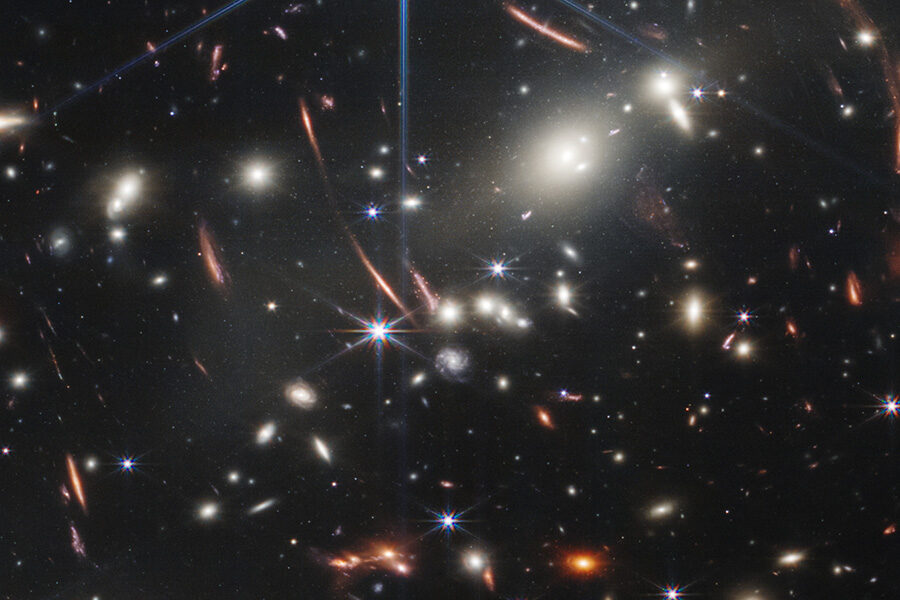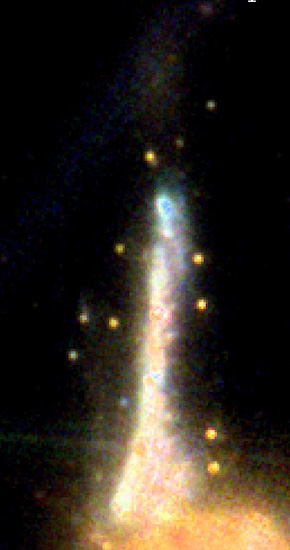Astronomers are using compact groups of stars to probe the history of a galaxy in the adolescent universe dubbed “The Sparkler.”

NASA / ESA / CSA / STScI
The Sparkler is a small galaxy residing 9 billion years ago in the adolescent universe. It has only one-hundredth of the Milky Way’s mass in stars; however, over the eons it will grow to become the size of our galaxy. Looking back in time at this developing galaxy is enabling astronomers examine a growth spurt similar to what our own galaxy might have experienced.
Discovered in one of the first James Webb Space Telescope (JWST) images to be released, the Sparkler is distorted into a stick shape via the gravitational lensing of a foreground galaxy cluster. Gold-tinged star clusters surround the galaxy — hence its nickname. Of the two-dozen objects, dubbed “sparkles,” five are likely to be globular clusters, dense clumps of ancient stars.
Lamiya Mowla (University of Toronto) and colleagues first analyzed the sparkles last fall, determining the clusters’ ages and chemical composition. They found that the Sparkler’s globular candidates are chemically enriched (what astronomers often term metal-rich), indicating several previous generations of stars had already lived and died within them. Other sparkles, which appear more extended than the compact globulars, are metal-poor.

Mowla et al. / Astrophysical Journal Letters 2022
Now, in a new study, Duncan Forbes (Swinburne University, Australia) and Aaron Romanowsky (San Jose State University and University of California, Santa Cruz) are comparing the Sparkler’s star clusters to those around galaxies closer to home — namely, our own — to understand the galaxy’s history. The study appears in the Monthly Notices of the Royal Astronomical Society.
The Milky Way hosts more than 150 known globular clusters, most of them orbiting well outside its spiral disk of stars. Some of these globulars probably formed early on; although their origins aren’t well understood, they must somehow have been incorporated into our infant galaxy as it came together. Other globulars joined the Milky Way as it gobbled up other galaxies and their accoutrement.
A second group of reference points are the globulars around the Milky Way’s largest satellite galaxy, the Large Magellanic Cloud (LMC). The LMC is about the same size now that the Sparkler was all those 9 billion years ago. Eventually, if the LMC is absorbed after multiple passes, its globulars would join the Milky Way’s collection.
A final point of comparison is the dwarf galaxy Gaia-Enceladus. It no longer exists — the Milky Way’s gravity tore it to shreds 9 billion years ago — exactly the timeframe at which we’re seeing the Sparkler. But while the galaxy was destroyed, its globulars survived to join our galaxy’s stellar halo. Other astronomers have been able to identify which ones originally belonged to Gaia-Enceladus dwarf.
Forbes and Romanowsky ultimately compared the ancient sparkles to dozens of globular clusters around the Milky Way and the LMC. They find that the globular sparkles are like the metal-rich globulars around the Milky Way, which probably formed with our galaxy and orbit close to its disk.
Two of the more extended sparkles, which are metal-poor, appear to be akin to the globulars around the LMC and Gaia-Enceladus. Forbes and Romanowsky thus speculate that these two objects might actually also be globular clusters, only they’re newly formed and belong to a dwarf galaxy that’s falling into the Sparkler.
“We appear to be witnessing, firsthand, the assembly of this galaxy as it builds up its mass, in the form of a dwarf galaxy and several globular clusters,” says Forbes.
Astronomers have used age and composition measurements to conduct a sort of archaeology in our own galaxy, deriving the merger history of the Milky Way. But such analysis is complicated enough when we have the reams of data on the Milky Way that several sky surveys have provided. For distant galaxies residing in the long-ago universe, measurements become more uncertain.
Another study, led by Adélaïde Claeyssens (Stockholm University), examined the same light from the candidate globular clusters around the Sparkler, and found that they’re metal-poor rather than metal-rich. She and colleagues are now working toward clarifying the differences in the measurements. Forbes and Romanowky acknowledge in their study that the ages and metallicities of these clusters “deserve further study.”
 3
3









Comments
Rod
February 22, 2023 at 7:20 am
Good report, the article starts out. "The Sparkler is a small galaxy residing 9 billion years ago in the adolescent universe. It has only one-hundredth of the Milky Way’s mass in stars; however, over the eons it will grow to become the size of our galaxy. Looking back in time at this developing galaxy is enabling astronomers examine a growth spurt similar to what our own galaxy might have experienced."
Interesting interpretation and extrapolation. The reported redshift is 1.378 so the comoving radial distance today is some 13.69 Gly distance well beyond the 9 Gly look back distance reported and more than 4 Gyr older too now or today. In the BB model, we do not see the galaxy at this distance (13.69 Gly), and the more than 4 Gyr of evolution said to take place in it. Distance and time concepts like this in the BB model when explaining what we see in small galaxies and comparing to the MW we see today, I think are important to point out.
You must be logged in to post a comment.
Monica YoungPost Author
February 23, 2023 at 9:57 am
Hi Rod,
We default to lookback distance/light travel time at Sky & Telescope because it is the most intuitive distance measure for readers to understand. It is also a measure that's easy to compare to the age of the universe, thus giving a measure of both distance and time. We're seeing the light that left this galaxy 9 billion years ago, thus we're seeing what it looked like when the universe was 4 billion years old. It is true that the current distance to this galaxy is now much larger than 9 billion light-years — which is why we strive not to phrase things like that :). But if you want to give the "actual" distance to the galaxy, do you give it in comoving radial distance? Or luminosity distance? Or angular size distance? Each one of these measures has advantages and disadvantages — but most importantly for communication purposes, they all give a different answer! (You can learn more about different distance measures here: https://astro.ucla.edu/~wright/CosmoCalc.html) By defaulting to lookback time as our distance measure, we can ensure consistency.
You must be logged in to post a comment.
Rod
February 23, 2023 at 1:35 pm
Very good Monica Young. I use that same calculator and some others too. Yes, the different distances and time scales are used in them. The size of the universe when the CMBR appears as light is some 40-41 million light year radius (as seen from Earth), that is the angular size distance when you use z=1100 for the CMBR postulated redshift, thus the universe size at z=1100 when the CMBR appears as light. The comoving radial distance is critical to using the look back time distance. That is where an object is supposed to be today, if observable and measured from Earth. We do not know what the Sparkler looks like at the comoving radial distance today 🙂
You must be logged in to post a comment.
You must be logged in to post a comment.